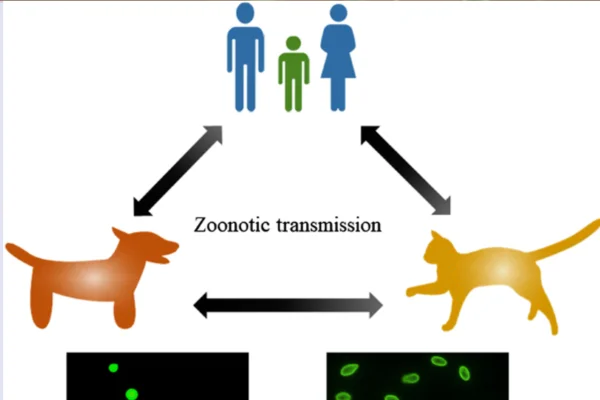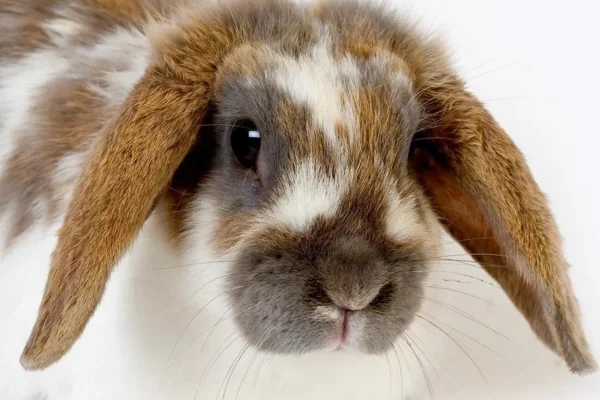Understanding Cryptosporidiosis:
Parasitic Disease Affecting Animals and Humans
Cryptosporidiosis is an infection caused by microscopic parasites of the genus Cryptosporidium. These protozoa are known to cause severe diarrhea in mammals, including humans and a wide range of animals.
Although it is commonly associated with outbreaks of water-borne diseases, cryptosporidiosis can manifest itself in a variety of situations, especially in environments with poor hygiene or frequent contact between humans and animals.
In this article, we will explore the causes, symptoms, treatment and prevention of cryptosporidiosis, focusing on its relevance in the veterinary and public health context.
Contents
What is Cryptosporidiosis?
Cryptosporidiosis is a zoonotic disease, meaning that it can be transmitted from animals to humans and vice versa. It is caused by the protozoan Cryptosporidiumis a parasite that lodges in the gastrointestinal tract of hosts, where it causes significant inflammation. There are several species of Cryptosporidiumbut the most relevant in terms of public and veterinary health are Cryptosporidium parvum e Cryptosporidium hominis.
These parasites are highly resistant and can survive for long periods in external environments, especially in water. Once inside the body, they multiply in the cells of the intestine, causing damage and interfering with the absorption of nutrients, which results in the characteristic symptoms of the disease.
Transmission of Cryptosporidiosis
Cryptosporidiosis is mainly transmitted by ingesting oocysts (infective forms of the parasite) present in contaminated water or food. Fecal contamination is the main means of spread, both in rural and urban environments. Infected animals excrete millions of oocysts in their feces, which can then contaminate soil, water and other foods.
In animal husbandry environments such as farms, cryptosporidiosis can spread rapidly due to the proximity between animals, especially in areas where hygiene conditions are poor. Young animals, such as calves, are especially vulnerable to infection. Humans, in turn, can contract the disease by handling infected animals or coming into contact with contaminated surfaces or food.
Furthermore, cryptosporidiosis is a growing concern in water supply systems, since the Cryptosporidium is resistant to conventional water treatment methods, such as chlorination. This has led to significant outbreaks of waterborne diseases in various parts of the world.
–
Symptoms of Cryptosporidiosis
The symptoms of cryptosporidiosis can vary depending on the host, but the most common is watery diarrhea, which can be severe and debilitating. Other symptoms include:
- Abdominal pain and cramps.
- Nausea and vomiting.
- Loss of appetite.
- Significant weight loss.
- Mild fever.
In humans, symptoms usually appear two to ten days after infection and can last up to two weeks. However, in individuals with compromised immune systems, such as people with HIV/AIDS, cryptosporidiosis can become chronic and lead to serious complications, such as extreme dehydration and even death.
In animals, especially calves, severe diarrhea can be fatal if left untreated. Cryptosporidiosis in calves, for example, can lead to significant economic losses on farms due to animal mortality and decreased productivity.
Diagnosis of Cryptosporidiosis
Diagnosing cryptosporidiosis can be a challenge, as the symptoms resemble those of many other gastrointestinal infections. However, confirmation of the disease is usually made by detecting oocysts in the feces of the infected patient or animal. Specific laboratory tests, such as microscopy with special staining or immunofluorescence tests, can identify the presence of oocysts. Cryptosporidium.
In humans, blood tests and other diagnostic tests can also be carried out to assess the severity of the infection and the impact on the immune system.
Treatment of Cryptosporidiosis
There is currently no specific, fully effective treatment for cryptosporidiosis. The main focus of treatment is symptom management, especially dehydration caused by diarrhea. It is essential to ensure that the infected patient or animal receives enough fluids to replace fluid and electrolyte losses.
In humans, the use of anti-parasitic drugs such as nitazoxanide has shown moderate efficacy in some cases. However, for individuals with compromised immune systems, treatment can be more complex and include antiretroviral therapy, in the case of HIV patients, to restore immune function.
In animals, especially in veterinary medicine, treatment also focuses on symptom management. The administration of intravenous fluids in severe cases may be necessary to prevent severe dehydration. Antibiotics and antiparasitic drugs can be used in more complicated cases, but the main focus is on preventing the spread of the parasite in the herd or among domestic animals.
Prevention of Cryptosporidiosis
The prevention of cryptosporidiosis depends mainly on strict hygiene and sanitation measures. Some effective strategies include:
- Personal hygiene: Washing your hands regularly, especially after handling animals or their feces, can significantly reduce the risk of infection. This is especially important for people who work at farms, veterinary clinics or animal shelters.
- Adequate Sanitation: Ensuring that the water supply is free from contamination by feces is essential. Water filtration systems that remove oocysts of Cryptosporidium are an important defense against waterborne outbreaks.
- Animal Hygiene: Maintaining good management practices on farms and in other animal husbandry environments can help prevent the spread of the parasite. Isolating infected animals and ensuring that their living quarters are cleaned properly is crucial.
- Watch your diet: Washing fruit and vegetables thoroughly before consumption and avoiding drinking water from unknown or untreated sources can prevent accidental ingestion of oocysts.
Cryptosporidiosis and the Public Health Context
Cryptosporidiosis is a growing concern in the field of public health due to its ability to cause large outbreaks, especially in regions where basic sanitation is poor. Developing countries, where access to drinking water is limited, are particularly vulnerable to outbreaks of waterborne diseases such as cryptosporidiosis.
In recent years, there has been an increase in global efforts to improve the detection and control of cryptosporidiosis in humans and animals. The World Health Organization (WHO) and other health bodies have encouraged the implementation of better sanitation and water management practices, as well as hygiene education programs for at-risk populations.
Furthermore, cryptosporidiosis is a classic example of a zoonotic disease, highlighting the importance of the "One Health" approach, which recognizes the interconnection between human, animal and environmental health. Surveillance and control of diseases like this requires close collaboration between human health professionals, veterinarians and environmental specialists.
Conclusion
Cryptosporidiosis is a complex parasitic disease that represents a significant challenge for both human and veterinary health. Although there is no specific treatment that is completely effective, prevention through strict hygiene and sanitation practices is the best defense against the spread of the disease.
Awareness of the risks and the implementation of preventive measures are essential to control this infection and minimize its impact on public health and animal production.
By better understanding the causes, symptoms and ways of preventing cryptosporidiosis, we can protect ourselves and the animals around us from this parasitic disease. Cooperation between different health sectors is key to tackling this global challenge and ensuring that outbreaks can be controlled effectively and quickly.








